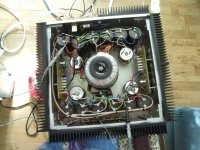my amps have a perforated cover over it with 2mm holes, i think that that is the only reason i can get some heat in there.
the cover is a wrap around, only the bottom of the heatsinks is open and about 3cm above the floor.
I like your foot solution a lot better than the acorn nuts I used on my A75.
i was thinking of the mechanical expansion myself, but there are ways around that part of the problem.
problem is, even while looking on the internet, i can not find much about heat conductivity.
problem is, even while looking on the internet, i can not find much about heat conductivity.
I like your foot solution a lot better than the acorn nuts I used on my A75.
old door handles from a kitchen 😉
i got about a 100 of them, so i will be using them in my next builds to.
a bit cramped?
i see free space.
but i wonder, what are the silver/chrome things next to the caps?
i see free space.
but i wonder, what are the silver/chrome things next to the caps?
They were the washers that I used to hold the coils in place for the CLCC power supplies. Not metal, just plasticised chrome. I don't have a photo of the final iteration, but the colis for the PSU were ultimately mounted with nylon threaded studs.
oke, nothing exotic.
at the moment i am working on new small diy heatsinks to use in my BZLS.
i am still running my alephs on a C-77 pre-amp from sansui. not realy bad for a el cheapo pre, but still, the aleps deserve a lot better.
in my alephs i also use small copper diy heatsinks, they work great, better than i would have thought.
at the moment i am working on new small diy heatsinks to use in my BZLS.
i am still running my alephs on a C-77 pre-amp from sansui. not realy bad for a el cheapo pre, but still, the aleps deserve a lot better.
in my alephs i also use small copper diy heatsinks, they work great, better than i would have thought.
in the 15 years since I discovered it.
After reading your post, figured I'd do some googling.
Pretty much as I posted earlier (including the kitchen tiles
 ).
).Way superior to using a larger heatsink, for a reference : EUVL/Patrick's article in Linear Audio.
Attachments
Isn't it great that people all over the world can inspire us to learn and/or teach us fun stuff (most often when we are supposed to be working  )?
)?
 )?
)?Isn't it great that people all over the world can inspire us to learn and/or teach us fun stuff (most often when we are supposed to be working)?
it is great, especially now that my wife and kids are on vacation.
finally peace and quiet in the house. 😉
from Wiki:i am just thinking aloud here, but would mercury be a good heat spreader?
make a thin walled enclosure, leak proof, fill it with mercury and than attach it to a normal heatsink.
i know it is not practical, but i am just trying to learn a thing or two here.
"Mercury is a heavy, silvery-white metal. As compared to other metals, it is a poor conductor of heat, but a fair conductor of electricity."
from me: I want to use Hg as flotation for isolating transformers! (although I will probably just use elastic straps...)
- Status
- Not open for further replies.
- Home
- Amplifiers
- Pass Labs
- DIY heatsinks
